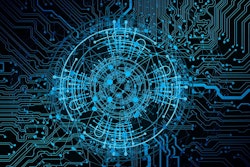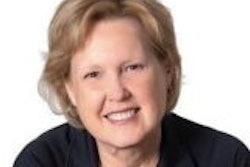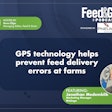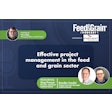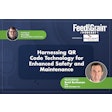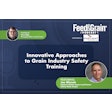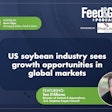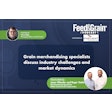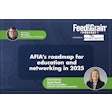In part one of a two-part podcast series, Steven Kilger talks with Easy Automation's Brady Gaalswyk about the current state of automation in the feed industry and what the next step in the industry's automation story might be.
Steven Kilger: Hi, everyone. My name is Steven Kilger, and the managing editor of Feed & Grain. And you are listening to the Feed & Grain podcast. Thanks so much for joining us today. I am talking with Brady Gaalswyk from Easy Automation. He is a second-generation expert in automation and is going to talk to us a little bit about the evolution of automation over the years, where we are now and where we might be in the future.
Thank you so much for listening. A little bit of housekeeping. This is going to be the first of a two-part automation special, where we're going to go even deeper into automation with some different experts. And if you like it, and you like the Feed & Grain podcast, and you have any suggestions for guests or topics that we should cover, please go to feedandgrain.com/podcast. And there's a submission form there that you can reach out directly to me and suggest any topics or guests for us. Thank you so much for listening. And Brady, thank you so much for joining.
Brady Gaalswyk: Hey, I'm doing well, Steven. I appreciate the opportunity to join in and talk with you guys today.
Kilger: Yeah, automation has always been a fascinating topic for me. I've kind of covered it since I've gotten to this industry. And let's face it, if we're gonna feed all these people, and by 2050, we're gonna need automation to really help out with that, especially at this moment. So thanks so much for stopping by. It's great to talk to an expert.
So why don't you tell us, me and the listeners, a little more about you?
Gaalswyk: My name is Brady Gaalswyk. I'm part of the second generation here at Easy Automation.
My background is that my parents started Easy Automation back in 1986. We were hog farmers. So we started automation right around the time when the PCs got to be involved in it. Things have obviously changed a lot since then. My background is from a family perspective, but as well as I was working with my uncle's and trucking company that delivered to feed mills and grain facilities actually do a lot of the same type of people I work with today. But on the trucking side of business, delivering the ingredients or dispatching for delivery of ingredients. A lot of the pain points around inventory management and that kind of stuff, right? Or documentation, all that kind of thing.
So I got to learn about the feed industry from a couple of different perspectives there.
Kilger: Well, yeah, you're the perfect one to talk about about the history of automation because you've been around it your entire life, pretty much in the feed industry. So that's amazing. What would you say are some of the key breakthroughs that you've had in Automation?
Gaalswyk: When you talk about key technology breakthroughs, it really just depends on how far back you want to look at what's a breakthrough, right? What's a breakthrough? And what's old news to us? Now.
We want to talk about previously, way, way back in time, going from circuit boards to computers, to PC base. So having a lot more capacity, in terms of memory, a lot faster, much more data collection, I mean, much more back at that time 30 years ago is a pretty relative, but the start of the modern automation, as we know it today, where it's kind of a PC PLC based, combined together. And as they slowly Did more and more data over that. Now, as we talk more about the last 10-20 years.
Some things are additional Safety and Hazard monitoring. The physical hardware components that we're seeing on the equipment are given the automation, just that much more information to make decisions of know what's going on with that equipment. So instead of simply turning on and off equipment, we're also bringing in the information about how it was running. Are there any problems? Now that troubleshooting aspect, as we continue to walk through a little more recent if you will.
And notice you talked about controls and automation, and it is to kind of do the same, but they're different at the same time, right? Controls are a little bit more the controlling of the facility. And automation, I consider it even a little broader in terms of automation or both the facility and the controls developed but just overall processes and human interaction throughout that. So more recently, the adoption of APIs or applicant Application Programming Interface phases has allowed automation to no longer just act as its own little island where it's supposed to make feed. But being truly integrated into with the rest of the operation in the office processes, the business processes, and the accounting processes to be more seamless throughout some of that. And then another thing that's a technology breakthrough that maybe doesn't even get thought about that much as it relates to specific automation, but the availability and speed of internet in rural areas, right now, I think we all can say that we have room for improvement on this. But even with that being said, we have come a long way. So that's had a big impact on our ability to control facilities.
From a single location and pulling data from multiple facilities, as well as more points of view, the ability to provide remote support, and just overall, a better customer experience because of that.
Kilger: Yeah, definitely. I mean, we all have phones in our pockets, right? And they all now have the ability to broadcast their own Wi-Fi network and get service just about everywhere now. So that really is kind of a game changer and hopefully improves over the next couple of years. When I think of automation and kind of history, it seems like it's really gone from simplicity, right? Before you have turnkey facilities where everything's manual, and then you go to, oh, I can do this one thing to oh, I can do many things. Oh, I can go to do many things and also analyze.
We talked a little bit about the Internet; what do you think it is like, oh, kind of what's the newest technology out there that you think is like really going to change the game for the industry?
Gaalswyk: Changing the industry is heavy around the data, the concept of industry 4.0. Porting of data using that, as well as the concept of implementing artificial intelligence to that data. So not only have a whole pile of data at your fingertips but how to have processes to look at that data and make decisions that are being made by humans? Because of that data, some things that I see is, looking at preventative maintenance issues where equipment is acting in a specific way and starts to change how it acts maybe just very slightly and how it changes. Or maybe it's just very slightly how it's changed running this facility, compared to what the norm is, across all your facilities, if you had all that data to compare it, you're better able to see, okay, that thing's gonna fail in two weeks, right?
We're now, if we're honest with ourselves, in our current level of automation, we either know that it's working well, or it's really starting to have a problem, right, that we, being able to have more access to that data and see those trends and minute changes and most trends is going to have prevented things from happening in the future bad things will happen, I should say.
Now, the way AI is to be implemented would be like, forecasting and optimizing a facility. When I say optimizing the facility, it's not just how fast is this batching feed. It's what order should be putting here to maximize the throughput to then maximize my loadout storage to then maximize my delivery trucks. truck delivery schedule? Do you have the fastest plan in the world, and this is waiting on loadouts because the trucks are not getting back fast enough? That's not truly helping your capacity. Right? It's trying to streamline your entire process is where I see things going.
Kilger: Yeah, really cool. That maintenance part of it alone. Seems like it's well worth it to me because, especially with today's the day and age we're in where everything takes a really long time to get to you or manufacturer, just knowing that that repairs going to be going up seems like it would make the whole thing worth it. To me, at least.
I don't actually run a feed mill. I just learned about it for a living.
Gaalswyk: I was gonna say you have a lot of exposure, Steven. I mean, you are right in terms of maintenance. As the piece of equipment is gotten bigger, just that many more tons are getting pushed through that single piece of equipment. Just more than a single piece of equipment has been relied on to feed more animals, right? So we just got to make sure that that piece doesn't fail, or we know what's going to happen and be able to cut off the paths.
Kilger: You visit a lot of feed mills; you talk to a lot of feed mill managers and owners. What do you kind of see as the opportunity that the industry should really be like jumping out now? Especially one of the easier ones to deal with.
Gaalswyk: When I was thinking about this a little bit, I was trying to think probably more so on at first, the far off the really cool stuff. I'll do what we should be jumping on. But as I think about what would have the biggest impact on the industry, and kind of think about, like, if you will step back with me for a second, but the adoption curve or people call it the innovation curve, where you have those innovators, and these are some of the things that they're implementing that are some of that cool new technology that we just talked about, right? We have just such a big percentage of the feed industry as a whole that you could call the early majority, your late majority, or even laggards as it relates to this innovation curve. And facility. So there are just so many tons of feed being produced all over the country, with, pretty limited automation, actually. Right. So maybe they've implemented some of the basics, such as the batching system, but we just have a lot to gain in terms of, taking existing automation of existing facility and just adding, receiving a reclaim.
It's crazy the number of load-outs at mills that are still run manually, and people are still watching it and running it manually. So things that are not necessarily even new technology existing technology that we have. But implementing that into existing facilities is a huge area of opportunity. And I think if anything more realistic than people sometimes realize, you might think we have an older facility and older pellet mill we don't have all that fancy stuff. Well, sure, maybe you can't get it to the level that those innovators are building their new facilities, but there's a lot of good automation and process improvements that we can implement into an existing facility to really help things out. So that made it overly simplified, but it's truly an opportunity.
Kilger: Yeah, I mean, it is you talk to people still who are almost completely manual Mills and who have not upgraded. I always try to talk to people and make them know that it's more available than they think. Because like it's some of the like you said some of those older mills, you're like, ah, and there's nothing we can do here. Right? Yes. It's falling apart. It's got a bunch of 20 years worth of feed gunk on it.
But yeah, it's really amazing how those small changes can make a big difference, especially in the day and age we're in which, as we're having a big labor shortage throughout ... Yeah, everywhere in the country, but especially in rural communities. So automation, I mean, that seems like that bit the easiest way to kind of combat that. So you don't need as many staff to run such a small facility. What do you kind about what's out there that you think could help with that situation for feed mills?
Gaalswyk: Yeah. So I mean, I know if you're asking for a specific or just making way more generalities?
Kilger: I want it all. I've got nothing else to do today.
Gaalswyk: Perfect, perfect way to do today, if you. If have time, you bet. Well, I can talk about, just maybe some high-level stuff and then some more specifics of these processes that are being put in.
So a very common, why the road that I see at some of these older facilities is somebody that had been making feed manual, or almost manually, let's put that away for 20-30 years, and that person did a great job and maybe wasn't comfortable or didn't think that they would be comfortable with computers. So they just kind of did their thing that they knew their facility based on, the funny sound made if something started, that they were the automation in their head based on using all their literally all their senses to run that facility. Well, now they're getting to the age where they're retiring. And they're the only one that knows that facility, right? So as a cooperative or anybody making feed goes out to hire somebody new. A lot of times, that person is going to be in there, maybe 20 or 30 years old and not have a lot of experience in a feed mill, not know how something is supposed to sound if it's working, right? But they'd be very comfortable running computers very comfortable in training, learning on that type of thing, automation systems like we provide.
So you see that as a huge opportunity in terms of, you don't need to have people with all these years of experience and all this knowledge baked in the time, you can simply have a system, training somebody on a system over the course of a couple of days or weeks, and they can make the literally hundreds of 1,000s of tons of feed in a short time or once it might take you 10 years to get to that level of knowledge, right. So speed of ramp up overall. And the benefit of that too is that person's feeling good about themselves that they're making a lot of feed they're, doing an educated knowledge of running the system and not just simply staring at this engage all day long, making sure it doesn't go out of this range. So they feel better about themselves and in the quality of work that they're doing, not to mention able to do it faster.
And then just decreasing the manual processes in both changing things or running a facility, but down to two to truly manual processes. So, I mean, we've seen more and more people putting in micro ingredient systems or, or I'll say larger micro ingredients systems. So instead of having to do quite so many handouts, or bulk bags or tote unloaders, again. To go from 50-pound bags, and now 2,000-pound bags, right and like a forklift, less carrying less hauling, more loss of weight style to put in, like the drugs or even small ingredients, these are the type of activities that were otherwise somebody would have to do a manually process every single batch of feed that is made. and the more you can.
Because the pure amount of time that somebody would have to be there just in case they ran one of those batches or actively being involved in every single one of those batches has to be a lot of hours to cover. So some of those types of processes are some of the things that we're seeing people implementing automation for the labor shortages.
Kilger: Yeah, just to interrupt you for a second, like, well, it's like hand ads and things like that to you. And also, it's one of those mistakes, right? Because if you do something 1000 times, eventually you're gonna forget, or you're gonna mess up once.
Gaalswyk: Absolutely, or at least it'll record it. Now, we also have handy stations where it records the actuals, don't get me wrong. But not only having the automated additive automatically recorded, the whole nine yards, but you also have to get the benefit on both sides.
Another one that I've seen more and more people in implemented on the loadout side of things. So there are a lot of facilities out there that were called truly manual loadout. Somebody's running up a ladder, opening up a slide gate, watching the feed going in. It's cold, it's windy, climbing up a ladder, right? So we're seeing different processes put in, such as camera loadouts, where the drivers can simply load themselves not having to get out of the truck.
Again, makes it just that much faster, easier, and safer. Right? These are the at its core. That's what we're trying to do.
Those things all save so much, so much time. And a lot of people think of it that way. Right? It's time-saving. But as we mentioned, it's also having a log of making sure mistakes are categorized and done. And then also for everyone's safety, right? There's no reason some, like you said, some guy needs to go climbing up there in the middle of winter. When it's snowing and do all that stuff. There's just no reason for that anymore. So yeah, all that's all those are great examples.
Kilger: So let's, let's talk a little bit, let's change gears and talk a little bit about where people should get started. So say you've been listening to this podcast, and you're like "we really do need to finally make the jump on this." Where do you suggest that kind of get started? When you're, if you don't already have a kind of a service provider that you're working with? What do you what do you suggest?
Gaalswyk: Yeah, so overall, I think it'd be good too. Starting can be lots of different things. Maybe mean base automation, maybe it means no automation, maybe it means looking at pushing electric buttons, but no, wherever you're starting from.
I would be talking to a provider and talk to them about some of the things you're trying to take to implement now. Some of your headaches, some of your bottlenecks, just overall your opportunities. And I would encourage you to share not only what your near-term plan is but what's your long-term plan, right?
We all know, especially if you're starting out a basic, we'd all like to start getting to point B a lot faster, maybe. But if you share that long-term plan and long-term vision of how you see your facility changing over the course of the next three, five to 10 years, what you expect out of this facility, what different processes you're going to be implementing, we can help design the automation system itself, the cabinets, the whole nine yards to give input on. So you don't pigeonhole yourself, right? That we see a little bit too often where people think that they're going to just try to do something basic and start out just step one, they can kind of do it themselves and just have somebody who's experienced in the feed automation. And really, it's best to start out with your angle, at least as far as the discussion. And then we're happy to start out at that base level and then build modules.
So maybe again, if you run a truly manual, batching would be commonplace to start out with, right? Every single time your feed is going through the batching process. Not only that, but Steven, as you talked about, that's the vital point where we want to record exactly what happened exactly what we put in there, both for tracking and tracing, as well as for inventory accuracy and personal purposes, right? So that's kind of our heart if you will, and then kind of continue to work out through there. But just knowing that the long-term plan, and maybe because your long-term plan is to get automated, that even though you're not there today, might make sense for when you add that distributor to you an electric distributor, right? So to do your setup, this way so that in the future, we can automate more, get your equipment with this type of sensors. And to be able to add later, we can just help you do help you to maximize it done. In long run, even though by no means do you have to do it all at once. All even say the arm norm is even start with very basic and add on systems over time, as your operation changes, grows, can justify that expenses, right, the whole nine yards.
Kilger: Yeah, that's a really good point that it doesn't have to be an all-or-nothing situation, right? You can slowly build and get it to where you want it and talk to you and companies like you. It's always really fascinating to me because it's not like a lot of other equipment where you buy it, and it gets installed, and then you don't talk to them. Unless there's a major problem with providers like you, it's a, it's really a relationship, right? Because there's always going to be updates, and there's always gonna be things you can do, and you are going to always be there to kind of help them through that. So that's, that's a really important thing, too, is to recognize that, especially in this with automation and control systems, it's a partnership, right, like it's a real duty, you really do need to kind of like and work with your professional you're working with just to do that. And I always found that really an interesting part of your, your part of the industry.
Gaalswyk: You took the words right out of the mouth, right? It's not just buying a widget; it's a kind of partnership because you're buying a partnership in terms of that package that you put together for the now and how you set that package up for the future. That person's availability and ability to support you when bad things happen, as well as your kind of hitching your wagon to a provider, what is that provider putting money back in development? Are they where are they at today? How are they going to take care of me tomorrow? And where are they going to be 10 years from now? Right? Are they going to be able to get me where I want to go? And stick with me as my operation continues to change and grow? And so yes, it is very much like a partnership ... a marriage. Lots of different words that describe it. Right. But yes, absolutely.
Yeah. I mean, especially with digital technology, it never stops evolving. So it's, hopefully, in 10 years, we'll be talking about completely different things. So it's, it's important to have that long-term relationship.
Kilger: This is a little more of a broad question. And it's one that I am really fascinated with because it's the industry has been talking about it for a while, but I've never really seen any in real life. And that's a totally kind of Lights Out facility, that when you go home, that the facility still runs, and you can check on it your phone, and it'll send you alerts if something goes wrong, but there doesn't actually have to be anyone there. Are we? Are we getting closer to that? I've seen it getting closer, especially with things like these automatic loadouts and things like that happening. But what's your view on that kind of part of the eventual game plan?
Gaalswyk: Well, actually, I was gonna mention because it sounds crazy, where we've actually been doing this kind of thing for several years with literally nobody there; however, maybe on a different scale. It's on a smaller unformed pipe feed mill, right? So an on-farm feed mill where you have more control than in a commercial mill. But there are feed mills out there currently that the bin tells you when it gets low, it automatically puts the order in, it automatically batches that feed automatically. Then a lot of those types of mills then have a blowing system because, again, they're located right there on the farm. It directs it to that proper bin and automatically blows it to the bin connected to the barn. And literally, nobody's involved except for filling up some micro bins here and there; nobody's involved with it. They get alerts, and text messages on their phone if there's an error event or things like that.
So it sounds crazy. But some of those things that we actually have in those smaller meals, because you have more control and fewer things to control. We have already been able to do that. Now to touch on, the larger facilities or, kind of what we're thinking when people think about lights out in their mind. I definitely do think it's possible, I think; I guess I kind of view it the same way as I view it. Honestly, I don't have any experience, but like a windmill farm, right? There's nobody actually sitting at his windmill, much less probably even each location, each field of windmills, but there is somebody from a central location, probably watching hundreds, if not 1000s of different locations throughout the US or the world, probably. So the concept of nobody actually at that facility, or several facilities, but maybe one person kind of monitoring several facilities from a remote location as it relates to the high-level operations. And then maybe you'll either have it be lights out, or maybe have somebody a little bit less skilled person coming in just to kind of check things or fill bins and cleaning, that kind of stuff, but have the amount of truly skilled operated personnel potentially a long way away.
Kilger: Yeah, that's, that's really fascinating. I never thought that was a possibility. Because while I'm a millennial, so I think the lights out, and I think of myself sitting at home with my smartphone running the whole thing. But yeah, that kind of centralized location sounds, hopefully, like it'll really happen. As, especially with some of these larger companies, I have a lot of different feed mills all over the place. So that's really cool.
Gaalswyk: For sure, at least automation run during the night shift. Maybe they have day shifts, doing a lot of the things they do, some more administrative work and stuff at this specific location, but maybe have a night, one-night shift bathroom operator for three facilities? No, just purely filling all the load up bins overnight, right?
Kilger: Yeah, yeah, you're definitely gonna still need someone there. Unless we go get replaced by robots or something. Maybe that's the next step. Someone's gonna at least have to be there to sweep up. Speaking about robots in our eventual future, what do you think kind of coming along the line? What future technology out there has you excited about what it can do, especially for our industry?
Gaalswyk: We joked about it, but it's true in terms of just being increasingly mobile, right? And that can look like many different things depending on job responsibilities, depending on what we're talking about. But as it relates, you know, the concept is increasingly mobile, so control facility from mobile, ordering from mobile, more of your inventory of reporting capabilities, or just overall general production capabilities, more easily accessible on mobile. The normal traditional manager is no longer sitting at the desk at that one facility, and he's a manager at that location, much more so the case they're moving around, they spend less time at any desk than they do moving around, and they need to have that information at their fingertips to make decisions.
So kind of the whole process around feed mill automation, I see him become increasingly mobile on that, and then the other one would be traceability. Right so as time progresses, the more feed mills are becoming, as time progresses, the more feed mills are going to be treated and expected to have the same standards as that food production facilities. So you know, we've already seen that some on you know, organic or non-GMO or some of these more specialty type operations and I just see that type of thing increasingly become the norm for our from our traceability perspective is this kind of the future that I see the expectation that no longer a nicety or only for these specialties but the norm.
Kilger: Yeah, the feed industry and even our other industry that coverage, you know, the grain handling industry, we've kind of gotten away with, you know, that being someone else's problem. But we've all been to trade shows I've done the last couple of years, and traceability really is on everybody's mind. So yeah, to have your systems kind of go in there and be able to keep track of some of that seems, you know, going to be necessary. Especially like you said with different crop varieties, like just having said something of value, add a graph to it. You want to make sure that you're getting what you asked for.
Gaalswyk: It's something that is a unique thing to tackle. And we already have to go on those on those specialty things non-GMO, but just the pure aspect of the bulk material compared to, it's much easier to keep track of car tires and where what car tires came from here to there. And you can count for from showed up and five, you know, five of them left, right or whatever, he was much more different when you put a whole bunch of different types of grain in a bin and mix it up, and how does it come out? And in what order does it come out? And those are the kinds of things that we're working on to solve some of them, but I think there's room for improvement and ease of use and how we go about that.
Kilger: Yeah, definitely. So are there any technologies kind of being used by other industries that you think would be helpful to the feed industry? That you don't seem to get adopted very often, but maybe are more commonplace there?
Gaalswyk: I've seen some in the feed industry and kind of common, but it more wildly developed or implemented in other industries would be blockchain, tracking and tracing. I mean, just a perfect example of when a grain starts at one place goes to another place, you know, transferred by this truck goes to this facility, transferred to this feed bin to be fed to these animals, right? There's, you know, there's a lot of steps along that process. And a concept like core technology, like blockchain, would help us tie all that together. We're a little guilty of, yeah, we can tell you exactly what happened from the moment it came in the driveway as a raw ingredient to the moment I left the driveway or even got to the feed bin. But after it's done with the feed department, or done with the grain department or done with the live production, I think we have some gaps in between those.
Kilger: So yeah, definitely. I believe Bitcoin for ruining the name blockchain and everyone's mind. They're very different. But it's, I remember having it explained to me the first time wow, this makes sense versus, you know, the Bitcoin version of gobbly gook to almost everyone's ears. So yeah, I also think that would be great technology. Well, is there anything else you want to talk about? While I have you here?
Gaalswyk: No, I was gonna mention, I look back here to my notes about, you know, adopting more an area for improvement. You know, inventory management seems like a simplistic thing, where, you know, two loads go in, once you use two loads up, you're going to have nothing, right? It seems like a very simple thing that all computer technology has. But I just see people not fully utilizing their systems and the information that they have available to them. I think it's a concept that we, as providers, have to make that information fully live, even easier to use and better reporting. And those are the kinds of things that we continue to push forward.
Trying to make it easier every day. Well, that's just a common area I hear from the industry, and we've kind of made our own problem worse. If you will, let's say we had a mill that was supposed to make 1,000 tons a day when it was built, we're probably trying to push that thing to 1,200, 1,300, or 1,400 tons a day now. The bins are going to be the perfect amount of storage for 1,000 times a day of production. Well, now we're trying to squeeze that lemon just a little harder than we may be intended to. Right. So that makes it probably harder. So I think inventory management and what we can provide there and continue to improve upon is another big aspect. It doesn't matter how big your mill is if you're out of ingredients, and they're shut down and went down. It doesn't matter how fast an automation system you had built. It's in there, ready to rock and roll if they need any of that product in a timely fashion. Right. So that was just a little side note. I didn't mention being enough before.
Kilger: Yeah, definitely. Well, as you said, it's a lot easier when it's car tires, right? It's a lot harder when it's a billion granules of grain.
Gaalswyk: And actually in the concept of shrink and you know, different weights and that it's in, you know, you know, train load comes in, and 1, 000 truckloads go out or whatever. It's a lot to keep track of, so
yeah, yeah, definitely.
Kilger: Well, thank you so much for talking to me today. There's gonna be a link to Easy Automation, right in the show notes. So if anyone wants to check you out, they can go to you, so and I just want to thank you so much for stopping by talking with us.
Gaalswyk: Steven it's been my pleasure. Thank you.


